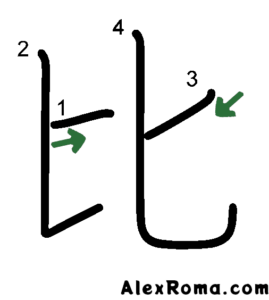Stroke order rule 10 – long crack first
A long time ago 漢字 kanji, or Chinese characters, used to be inscribed on turtle shells and animal bones for the purpose of divination. The inscribed bone was put on a fire causing it to crack, allowing the shaman to interpret the signs and find the sought answers.
The script used in these rituals was called 甲骨文 kōkotsubun.
- 甲 KOU ⇒ turtle shell;
- 骨 KOTSU ⇒ bone;
- 文 BUN ⇒ writing.
甲骨文 kōkotsubun evolved in style throughout the millennia to become the modern kanji.

Surprisingly most kanji preserve in their modern forms the very original shapes and ritualistic meanings that the ancient characters depicted.
The shape 卜 uranai ‘divination’ represents a crack on an oracle bone. Stroke order rule 10 says:
In the shape 卜 uranai, the “long crack” is written first.

In the highlighted 卜 uranai shapes, the long vertical stroke is always written first.
Remember that this is a stroke order rule, and these shapes don’t necessarily possess the meaning of 卜 uranai within all kanji.
The kanji 比 kuraberu
To conclude rule 10, let’s talk about the kanji: 比 kuraberu ‘to compare’.
This kanji is made up of two repeated ヒ hi shapes, which is not a 卜 uranai shape. The shape ヒ hi represents a dead person (a corpse).

The long crack first rule doesn’t apply here, even though the shapes are somehow similar. The kanji 比 kuraberu presents one of the most counter-intuitive stroke orders and should be practised and memorised as it is.
Pay close attention to how even the stroke directions of the shorter strokes (strokes 1 and 3) move to opposite directions. It’s the same shape repeated twice, so anyone would expect the same strokes to behave in the same way, but that’s not the case here.
This was the last of the ten stroke order rules. We can now move on to the kanji component rules.
